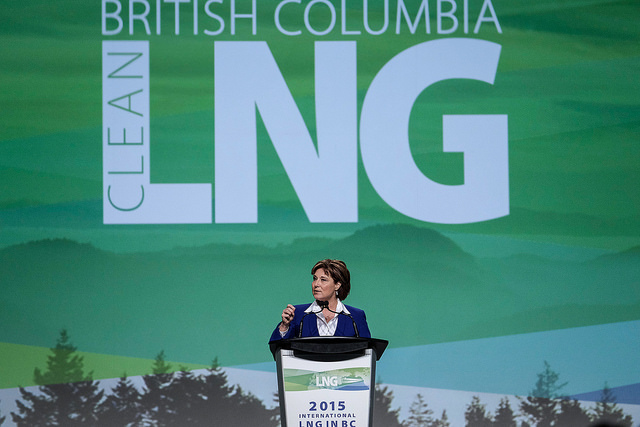Like this article? rabble is reader-supported journalism. Chip in to keep stories like these coming.
Since the signing of the new climate treaty in Paris last month, there’s been plenty of debate as to whether the new global agreement is a turning point or merely more hollow promises.
The answer, as the CCPA’s Marc Lee has written, will be revealed in how governments and markets react. In particular, the litmus test will be whether governments, upon their return home, continue with plans to expand fossil fuel production, or instead are prepared to speak an essential truth — that most of these ancient carbon reserves need to stay safely in the ground.
Post Paris, many have noted that, given our new international commitment to keep global temperature rise to no more than 1.5 degrees over pre-industrial levels, it makes no sense to invest in new Tarsands infrastructure, be it extraction and refining capacity or new pipelines in any direction.
But this same logic is equally true with respect to B.C.’s dirty fossil fuel development, namely, fracked gas and new LNG infrastructure (again, both gas pipelines and LNG plants on the coast).
It’s time for the provincial government to admit that its LNG project is over, and similarly for the new federal government to clearly state that there is no room in our future for new fossil fuel development of this sort. (Notably, thus far, the Trudeau government has indicated it is prepared to extend the same tax credits to the LNG industry that the Harper government had on offer, a curious way to make real a commitment to ending fossil fuel subsidies.)
While the Alberta tar sands may represent Canada’s largest source of greenhouse gases, were B.C. to succeed in realizing its LNG dream, this new industry (along with the fracking fields in B.C.’s North East needed to fuel it) would constitute Canada’s next largest “carbon bomb.”* In short, B.C.’s LNG hopes are simply incompatible with any realistic notion of Canada meeting its obligations to keep global temperature rise to 1.5 degrees.
It makes no sense to encourage and facilitate the investment of billions of dollars in new long-term fossil fuel infrastructure when the logic of the Paris agreement tells us we should be managing our natural gas industry for wind-down, not ramp up.
And if the B.C. government won’t admit this, then the official opposition certainly should.
So far post-Paris, Premier Clark has publicly remained firmly in LNG booster mode, even as the economics favoring her pipe dream collapse around her. The premier insists a B.C. LNG industry would be doing the world a favour, by helping Asia move off coal. The claim does not hold, as we have outlined here and here. The simple truth is that natural (fracked) gas no longer has a viable role to play in transitioning us to a zero-GHG economy; that argument may have had some merit if we’d gotten serious about climate change two decades ago, but the moment is lost. Time is now of the essence, and we must leap-frog directly to zero-GHG energy sources.
Maybe in her heart Premier Clark herself knows her LNG dream is done. I suspect that’s why her government is now fast-tracking the Site C dam; its raison d’être has shifted from providing low-GHG electricity to the LNG and fracked gas sector to serving as Plan B for a northern jobs plan.
Only there are much better ways to spend $9 billion than Site C. Instead, such an investment could help catapult us into the post-Paris economy; it could represent a welcome and significant investment in building retrofits and energy conservation (thereby saving BC Hydro ratepayers money); district energy, geo-thermal, solar and wind projects; public transit and high speed rail — all while providing more jobs in more regions of the province.
And now, with oil prices as low as they are, is just the time to expedite such a grand transition. As the Economist Magazine has declared in reference to the oil price collapse: “Seize the day!” Or, as the Leap Manifesto states, the oil price drop is “a gift… a rare moment to look at what we have become — and decide to change.” LNG is a distraction, consuming vast government resources and pulling our focus away from what should be our core economic and ecological task. This post-Paris/oil price moment is an opportunity that calls for governments with vision.
Admit LNG is not the way forward, and move on. That is what a government would do if it were serious about 1.5 degrees. That is what real leadership for 2016 and beyond should look like.
*In November 2013, the Globe and Mail reported on an internal provincial government memo obtained via Freedom of Information, which highlights the havoc liquified natural gas can have on our GHG emission targets. You can find the piece here. But to highlight one paragraph: “A cabinet document prepared for Environment Minister Mary Polak in June calculates the LNG sector could increase emissions by 16 per cent at a minimum, and as much as ‘a doubling of B.C.’s total emissions, depending on the number of plants and the technology and energy options chosen,’ the document states. ‘At the high end of that range, B.C.’s natural gas sector emissions would be comparable to those from Alberta’s oil sands.'”
Photo: BC Gov Photos/flickr
Like this article? rabble is reader-supported journalism. Chip in to keep stories like these coming.



